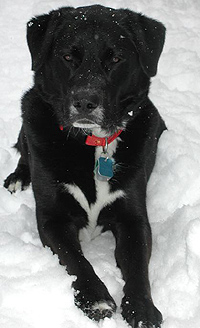
Back Perro de aguas de San Juan Spanish Saintjohninkoira Finnish Chien de Saint-John French St. John's Water Dog Italian セント・ジョンズ・ウォーター・ドッグ Japanese Anjing air St. John's Malay Sint-johnshond Dutch St. john’s water dog NB Cão de água St. John Portuguese St. John's Dog Swedish
| St. John's water dog | |||||||||||||||||||||
|---|---|---|---|---|---|---|---|---|---|---|---|---|---|---|---|---|---|---|---|---|---|
 A Newfoundland outport fisherman with his young St. John's water dog, photographed 1971 in La Poile, Newfoundland | |||||||||||||||||||||
| Other names | Lesser Newfoundland | ||||||||||||||||||||
| Origin | Newfoundland | ||||||||||||||||||||
| Variety status | Extinct. Not recognized as a breed by any major kennel club. | ||||||||||||||||||||
| |||||||||||||||||||||
| Notes | The St. John's water dog first developed on the island of Newfoundland sometime between 1494-1790 as European fishing dogs were brought to the region. During its development, Newfoundland was being colonized by Europeans; while contested, Newfoundland was primarily a British colony until Canada was formed in 1867 and Newfoundland voted to join the country 1949. The dog went extinct in the 1980s. | ||||||||||||||||||||
| Dog (domestic dog) | |||||||||||||||||||||

The St. John's water dog, also known as the St. John's dog or the lesser Newfoundland, is an extinct landrace of domestic dog from Newfoundland. Little is known of the types that went into its genetic makeup, although it was probably a random-bred mix of old English, Irish and Portuguese working dogs.[2] They were favourite dogs of fishermen because they had extraordinary qualities like good temperament and working behaviour. The number of St. John's water dogs started declining by the beginning of the 20th century. By the early 1980s, the landrace was extinct.
During the 19th and early 20th centuries, St. John's water dogs were exported from Newfoundland to England. These dogs were crossbred with other dogs to create the retrievers. It was the ancestor of the modern retrievers, including the Flat-Coated Retriever, Curly-Coated Retriever, the Chesapeake Bay Retriever, the Golden Retriever, and the Labrador Retriever. The St. John's water dog was also an ancestor to the large and gentle Newfoundland, probably through breeding with Rafeiro do Alentejos brought to the island by the generations of Portuguese fishermen who had been fishing offshore since the 15th century.
- ^ a b c d "St. John's water dog Information & Dog Breed Facts". Dogwell. Retrieved 26 April 2020.
- ^ Gosling, Samuel; Graham, Lindsay (2009-04-28), "Temperament and Personality in Working Dogs", Canine Ergonomics, CRC Press, pp. 63–81, doi:10.1201/9781420079920.ch4, ISBN 9781420079913
© MMXXIII Rich X Search. We shall prevail. All rights reserved. Rich X Search